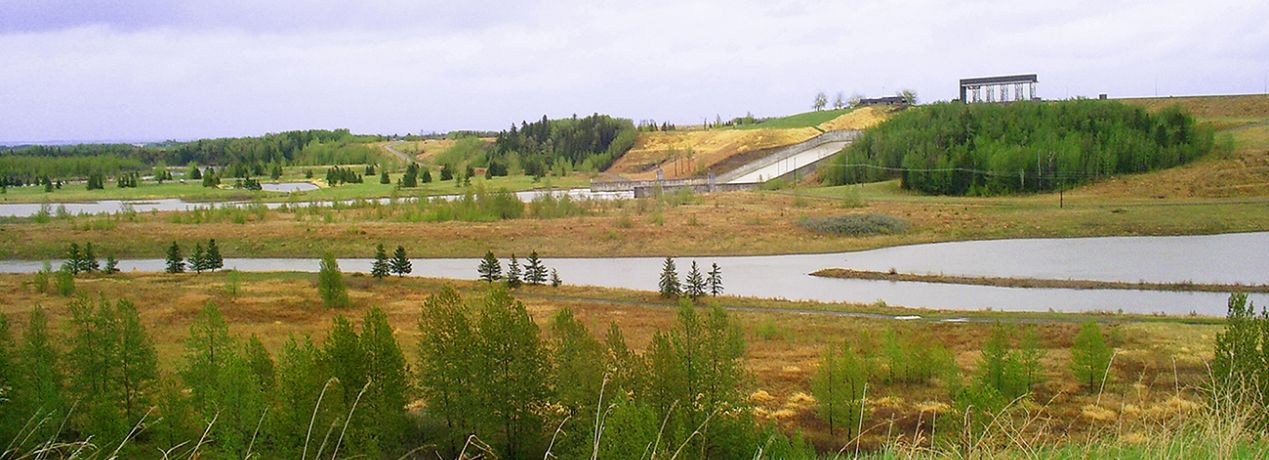Many energy companies in Alberta use dams when developing energy resources. We’re committed to holding industry accountable for making sure these structures are safe and for protecting the public and the environment from dam-related incidents.
How do energy companies use dams?
Companies use dams to contain various types of fluids, depending on the type of energy activity. Sometimes dams contain fluid wastes, such as tailings from oil sands mining and coal mining operations. Companies build ponds and dams to keep the waste in place until it can be treated and reclaimed.
Other times, dams are used to contain water needed to help recover resources, such as for hydraulic fracturing. In this case, companies inject water into the ground to help get the resources out of the ground. Ponds and dams contain this water until it is needed.
How We Regulate Dams
We regulate 202 of about 1500 dams in Alberta. The dams we regulate enclose 132 ponds used for oil sands development (68), coal mining (33), oil and gas operations (31), and in situ operations (5). Due to topography, multiple dams are sometimes required on a single pond.
Dam Safety Program
Our Dam Safety Program ensures that all dams used in developing Alberta’ energy resources are designed, constructed, operated, maintained, and decommissioned safely. The program also ensures that dam owners and our emergency response teams are prepared to respond in the unlikely event of an emergency to prevent harm to the public or the environment.
Inspections and Audits
We use risk assessments, inspections, and audits of an owner’s dam safety management system (i.e., how they are keeping their dams safe) to assess whether dam owners are managing their dams responsibly.
We inspect all dams every two to ten years, depending on the dam’s assessed level of risk (i.e., the severity of consequences if it failed and its historical performance), its size and location, the type of fluid it stores, and the type of project it’s associated with.
If we find a dam isn’t meeting our requirements, we will notify the owner and request a response to the noncompliance by a certain date. In the unlikely event of a dam failure, we will assist the owner in coordinating its emergency response.
Annual Inspection and Audit Results
Dam and Pond Map
Our Dam and Pond Map shows all 132 ponds that we regulate across the province. The tool can be used to find the names and locations of ponds and dams, as well as their size, type of fluid stored, related energy sector, operator, associated project, and the Canadian Dam Association's dam consequence classification.
For help using the map, consult the built-in help guide.
Our Journey With Dam Safety
In March 2014, we assumed responsibility from the Government of Alberta for regulating all containment structures, like dams, for fluid-storage ponds used in developing Alberta’s energy resources. We’ve since regulated dams according to the Water (Ministerial) Regulation- Part 6 Dam and Canal Safety.
In March 2015, the Office of the Auditor General of Alberta released an audit of Alberta Environment and Parks’ management of the province’s dam safety program. In the report, the auditor general made recommendations to improve how information is managed and shared with the public.
We accepted all of the recommendations in the report. In spring 2015, we launched our inspection program, which included reviewing past inspection data from Alberta Environment and Parks. Inspection guidelines were developed that consider, among other factors, risk and operator history and performance.
Meanwhile, as we were building and implementing our Dam Safety Program, our investigators were examining what led to a tailings dam failure and spill at the Obed Mountain Mine in October 2013. The spill contaminated water and damaged the creek bed of a tributary of the Athabasca River, and the contaminated water subsequently flowed into the Athabasca River and downstream.
The spill led us to ensure that our program is robust—so we can catch issues like the ones that led to the Obed spill before they happen.
In December 2018, Alberta Environment and Parks (AEP) updated the Water (Ministerial) Regulation to include an Alberta Dam and Canal Safety Directive. This directive forms part of the regulation and provides details and requirements for:
- the use of qualified professionals and qualified individuals;
- dam consequence classifications;
- the use of risk assessments;
- design, construction, and operation;
- dam submissions for approval/authorization
- dam safety reporting;
- dam safety and emergency management; and
- decommissioning, closure, and abandonment.
The regulation and directive apply to all dams in the province; energy dams regulated by AER and non-energy dams regulated by AEP.
In January 2020, we released Manual 019: Decommissioning, Closure, and Abandonment of Dams at Energy Projects. This manual was designed to help dam owners in their applications to decommission, close, or abandon energy dams regulated by the AER by outlining how we assess and process these applications.
Learn More
- Resource story: It’s Not Safety Be Dammed
- Resource story: Why We Give a Dam
- Lessons Learned From Dam Safety Incidents (2017)


